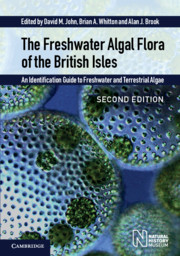 The Freshwater Algal Flora of the British Isles
The Freshwater Algal Flora of the British Isles Book contents
- Frontmatter
- Contents
- The online material (formerly provided in DVD format)
- List of Contributors
- Foreword
- Preface
- Acknowledgements
- Introduction
- Distribution and Ecology
- History of Freshwater Algal Studies in the British Isles
- Field Methods
- Laboratory Methods
- Water Framework Directive
- Cultures of British Freshwater Algae
- Classification
- Key to phyla
- Cyanobacteria (Cyanophyta)
- Phylum Rhodophyta (Red Algae)
- Phylum Euglenophyta (Euglenoids)
- Phylum Cryptophyta (Cryptomonads)
- Phylum Dinophyta (Dinoflagellates)
- Phylum Raphidophyta
- Phylum Haptophyta (Prymnesiophyta)
- Phylum Chrysophyta (Golden Algae)
- Phylum Xanthophyta (Tribophyta) (Yellow-Green Algae)
- Phylum Eustigmatophyta
- Phylum Bacillariophyta (Diatoms)
- Phylum Phaeophyta (Brown Algae)
- Primitive Green Algae (‘PRASINOPHYTA’)
- Phylum Chlorophyta (Green Algae)
- Phylum Glaucophyta
- Glossary
- Standard Form of Authors of Algal Names
- Sources of Illustrations or Material
- References
- Taxonomic Index
- Subject Index
- Plate Saction
- Miscellaneous Endmatter
- Miscellaneous Endmatter
Laboratory Methods
Published online by Cambridge University Press: 12 January 2024
- Frontmatter
- Contents
- The online material (formerly provided in DVD format)
- List of Contributors
- Foreword
- Preface
- Acknowledgements
- Introduction
- Distribution and Ecology
- History of Freshwater Algal Studies in the British Isles
- Field Methods
- Laboratory Methods
- Water Framework Directive
- Cultures of British Freshwater Algae
- Classification
- Key to phyla
- Cyanobacteria (Cyanophyta)
- Phylum Rhodophyta (Red Algae)
- Phylum Euglenophyta (Euglenoids)
- Phylum Cryptophyta (Cryptomonads)
- Phylum Dinophyta (Dinoflagellates)
- Phylum Raphidophyta
- Phylum Haptophyta (Prymnesiophyta)
- Phylum Chrysophyta (Golden Algae)
- Phylum Xanthophyta (Tribophyta) (Yellow-Green Algae)
- Phylum Eustigmatophyta
- Phylum Bacillariophyta (Diatoms)
- Phylum Phaeophyta (Brown Algae)
- Primitive Green Algae (‘PRASINOPHYTA’)
- Phylum Chlorophyta (Green Algae)
- Phylum Glaucophyta
- Glossary
- Standard Form of Authors of Algal Names
- Sources of Illustrations or Material
- References
- Taxonomic Index
- Subject Index
- Plate Saction
- Miscellaneous Endmatter
- Miscellaneous Endmatter
Summary
Ideally, all samples should be examined while the algae are still alive and as soon after collection as possible. Field observations are important in the case of crustose algae. For example, the blue-green alga Chamaesiphon and the red alga Hildenbrandia rivularis are easily recognized in the field, but often overlooked among scraped fragments when examined back in the laboratory. Some algae are extremely fragile and survive for only a very short period, so it is advisable to preserve at least part of the sample immediately on collection. According to Jane (1942), many flagellates are so delicate that characteristic features may be lost even in carefully fixed material. If samples are not preserved immediately, then precautions must be taken to keep them in good condition and to minimize deterioration.
Many algae decompose rapidly if too much material is placed in a container, so this should not be filled to more than one-third capacity. Stoneworts or charophytes are an exception, since they require plenty of water for support. Algae from well-oxygenated habitats, such as fast-flowing streams, usually deteriorate more rapidly than those from habitats where oxygen levels are at least sometimes low. To be kept in good condition, algae should be stored cool (below 15°C) and never exposed to direct sunlight. If specimens cannot be examined on the day of collection, they should be kept overnight in a cool-box or refrigerator. Some material remains healthy for several days if stored in this way, whereas other material (e.g. lake samples collected in summer) may deteriorate quite rapidly. If in doubt as to how long material can be kept alive, it is best to assume that it will start to deteriorate after a day, even though some samples may prove to last much longer. Material stored overnight in a cool-box generally shows no obvious morphological changes, although there are a few algae (e.g. Ulothrix zonata) which undergo rapid changes when transferred to warmer conditions. There is always the risk in storing unpreserved samples that animals, such as Daphnia and other small Crustacea, will devour the algae, as mentioned for phytoplankton samples. It is advisable to open containers of living material as soon as possible on return to the laboratory, or to pour any large samples into Petri dishes.
- Type
- Chapter
- Information
- The Freshwater Algal Flora of the British IslesAn Identification Guide to Freshwater and Terrestrial Algae, pp. 19 - 23Publisher: Cambridge University PressPrint publication year: 2021
